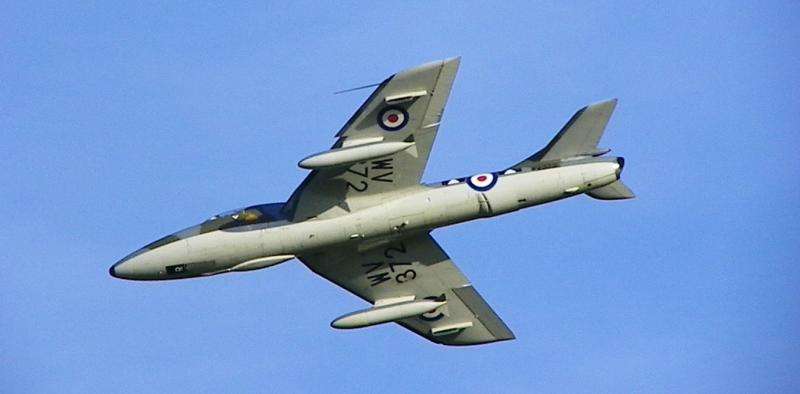Shoreham crash will bring safety changes, but airshows are here to stay

The tragic Shoreham Airshow crash has turned the spotlight on the safety of airshows, after a 57-year-old Hawker Hunter T7 failed to pull out of an aerobatic manoeuvre. With 11 and perhaps up to 20 people killed this should cause us to re-examine the industry in detail.
But let's first knock down a few issues not worth debating. First, several million people each year attend airshows in Britain alone, and many more worldwide. These are very popular spectator events, and that won't change: the age of the airshow is not over.
Second, that this aeroplane – an obsolete British jet fighter designed by Sydney Camm, responsible for the famous World War II-era Hawker Hurricane and the Hawker-Siddeley Harrier, the world's first vertical take-off and landing aeroplane – was 57-years-old is irrelevant to its safety. The regulations governing the continued airworthiness of aeroplanes are incredibly strict, and tens of thousands of pounds will have been spent annually on this single aeroplane to ensure its fitness for flight.
Third, whatever we may wish, we cannot eliminate the risk of accidents at airshows. While accident rates should be as low as possible, they cannot reasonably be zero, and I am quite certain that all airshow pilots and most airshow attendees recognise this. Accidents such as that which killed Gulf War veteran Trevor Roche in 2012, or former deputy chief of defence staff Sir Kenneth Hayr in 2001 were tragic – but those killed were participants who fully understood the risks.
What happened at Shoreham, however, where the jet failed to pull out of a dive and crashed onto a nearby busy road filled with traffic, is unacceptable.
Counting the cost
All aviation regulations take a four-tiered approach to safety: all third parties must be protected from death or injury as far as possible; consenting participants, such as airline passengers or airshow audiences, must be protected as far as possible, but not at the expense of protecting the general public; pilots and other aircrew should be protected from injury; and aircraft and structures should be protected from damage.
The crash at Shoreham caused the deaths of people who were not participants in the show, and so had not made any sort of informed decision as to the risks involved. Everybody in the aviation industry recognises that should never happen, and because of that there will be at least two separate investigations, already underway.
The first will be by the Air Accidents Investigation Branch (AAIB), a public body set up to investigate accidents "with a view to the preservation of life and the avoidance of accidents in the future". There will be a team at Shoreham collecting evidence, aiming to produce a report that identifies the main causes behind the accident and, more importantly, recommends how to prevent a similar accident occurring in the future.
Once the wreckage has been collected, this team will relocate to their base at Farnborough. There will be a great deal of evidence to sift through, although the age and size of the Hunter means there's no flight data recorder ("black box"), and instead the investigation will mostly involve photographic evidence, eyewitness accounts, and wreckage analysis.
The second investigation will be by the Civil Aviation Authority (CAA), the UK statutory body responsible for regulating all aviation in UK airspace. The CAA has many years experience of regulating airshows, much of which started from the tragedy at Farnborough Airshow in September 1952, when the prototype de Havilland 110 (which would become the Sea Vixen) broke up, killing the pilot, John Derry, his flight test observer, Anthony Richards, and 29 spectators.
Following Farnborough, rules were put in place that defined a strict "display line" away from spectators so that they would not be harmed by a crashing aeroplane. The faster an aircraft is, the further the display line must be from the official spectators, although non-paying spectators lining roads around airfields are a concern. A highly experienced flying display director is also required, usually supported by an expert flying control committee to oversee and approve the display. Those pilots flying in the display must hold individual display authorisations to do so.
This has demonstrated itself to be a robust system, and until Shoreham there has been no loss of life among spectators or the general public at a British airshow since John Derry's crash in 1952. But clearly on this occasion, something failed and allowed a high energy aircraft to point toward a busy public road, leading to deaths. The CAA has already decided to impose immediate restrictions, grounding all Hawker Hunters, and prohibiting high energy aerobatics at airshows. This is a knee-jerk reaction, although perhaps politically necessary, and should be revised following the investigation.
It is normal that rules found to have failed will be re-evaluated and improved, but politicians and the public have added to the clamour. Neither the AAIB nor CAA will cut corners with their investigations – it's important to do them right, and those seeking quick answers will probably be disappointed.
The investigation of this awful tragedy – which should never have happened – will result in revisions to the rules that oversee how airshows are conducted. It's far too early to say with any certainty what those changes will be, but this won't be brushed under the carpet. What's equally sure is that the saying often repeated by aviators – that all safety regulations were originally written in blood – remains sadly true.
Source: The Conversation
This story is published courtesy of The Conversation (under Creative Commons-Attribution/No derivatives).
![]()



















